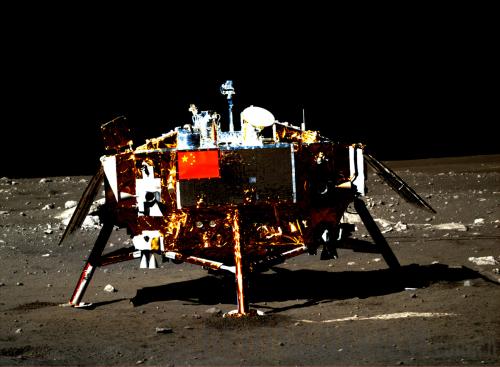|
 |
|
NEWCOMER: A photo of the Yutu lunar rover taken by a camera equipped on the Chang'e-3 lander after it was deployed on the Moon's surface on December 15, 2013 (XINHUA) |
The successful December 14 landing of China's Chang'e-3 spacecraft on the Moon, and deployment a few hours later of the Yutu (Jade Rabbit) lunar rover, have laid the basis for its long-term goal of the industrial development of the Moon. Following the success of the first two Chang'e-3 missions, which orbited the Moon, the current mission provides the on-the-ground intensive exploration that will lead to manned missions in the future.
China's lunar exploration program, which has been under development for more than a decade, is aimed first at the scientific investigation of Earth's nearest neighbor, and at taking an inventory of resources on the Moon. Eventually, missions will exploit the riches there, which are not gold or silver, but minerals which include a rare isotope of helium, which could power the thermonuclear fusion-energy-based economy of the future.
China is not "competing" with any other nation in its lunar exploration program. Contrary to press commentary, it is merely following a multi-decade succession of increasingly complex missions. Each mission tests new capabilities aimed at meeting its long-term goals. The challenging Chang'e-3 mission was the first time that China landed a spacecraft on another celestial body. It was the first time that any nation carried out its first extraterrestrial landing which included the deployment of a rover.
The success of the Chang'e-3 mission has given China's space leadership the confidence to accelerate its next phase in lunar exploration, including the announcement that returning a sample of rock and soil from the Moon to Earth will take place only three years from now.
What's new
In designing the Chang'e-3 mission, China had no intention of simply repeating the lunar missions that were carried out by the United States and the former Soviet Union nearly 40 years ago. The Yutu rover will, for the first time, use an on-board radar instrument to probe the subsurface of the Moon. Exploring the inner structure of the lifeless Moon with precision, down to a depth of 90 feet, will shed light on the development not only of this body, but of the Solar System as a whole.
The Chang'e-3 lander houses an ultraviolet telescope, a Moon-based "cosmic observatory," which will conduct astronomical observations from the surface of the Moon for the first time. A second ultraviolet instrument will study the Earth's ionosphere.
The rover, with a robotic arm similar to that on NASA's Curiosity Mars rover, will deploy instruments to describe the chemical and mineralogical composition of rocks on the Moon. On January 3, the Chinese Academy's Institute of High Energy Physics released to the world scientific community the first data obtained by the rover.
The institute posted on its website an initial analysis of data from the rover's Active Particle-induced X-ray Spectrometer (APXS), which can identify the chemical elements in the lunar soil. The data indicate the presence of eight of the expected major rockforming elements, and at least three minor elements. While these first results were not unexpected, they demonstrated that the instrument is working as designed. The release of the data and analysis to the public is an important policy decision by China, because it engages the global scientific community with the mission.
APXS was first powered up on December 23, and two days later was deployed to a position slightly above the lunar surface by the robotic arm, to go into its detection mode. Chinese scientists are pleased with the instrument's performance, and the institute says this is one of the best X-ray spectrometers deployed on a planetary mission.
Both the Chang'e-3 lander and the Yutu rover depend upon solar energy for their power, and so, hibernate during the two-week lunar night. Yutu is expected to awake to resume its three-month scientific mission on the lunar surface.
| 